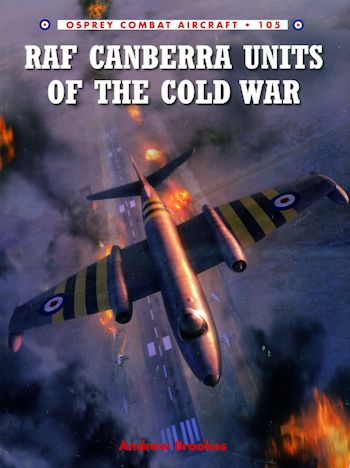 Every
once in a while, an aircraft turns out to be perfect right from the start. For
those of you following modern aircraft, you know that the F-35 does not come
even close to fitting that description. But in the late 1940s, the English
Electric Canberra certainly did. Once the design plans were finalized, a
prototype was built that was probably one of the most trouble-free new planes
ever built. After the initial flight, the only thing the test pilot could say
about it was that it had too much rudder. E.E. trimmed down the top of it and
the Canberra looked pretty much the same from that day until the last one was
built.
Every
once in a while, an aircraft turns out to be perfect right from the start. For
those of you following modern aircraft, you know that the F-35 does not come
even close to fitting that description. But in the late 1940s, the English
Electric Canberra certainly did. Once the design plans were finalized, a
prototype was built that was probably one of the most trouble-free new planes
ever built. After the initial flight, the only thing the test pilot could say
about it was that it had too much rudder. E.E. trimmed down the top of it and
the Canberra looked pretty much the same from that day until the last one was
built.
The British initially wanted a high altitude bomber and path-finder in the
mold of the Mosquito. Something that would be fast and not need any defensive
armament. Well, that is what they got, however, bombsight technology couldn't
keep up with the speeds and it was realized that something the size of the
Canberra wasn't what they needed. However, the plane was quite effective at
medium and low altitudes. Not only that, but did I mention it was fast? The test
pilot was able to throw the plane through the sky like a fighter and few, if any
fighter aircraft of the early 1950s could keep with it.
Eventually, the Canberra came to equip 34 RAF squadrons when usage peaked in
1955. This included not only bomber units, but also recce units and ground
attack squadrons. Once the V-bombers finally got into squadron service, the
number of Canberra units decreased as several of them converted to the larger
aircraft. However, there were units flying the Canberra in various guises up
until 2006 when the last one, a PR.9 of 39 Squadron made its final flight. The
type was not retired due to its lack of capability, but because it was getting
too expensive to maintain.
In this book by Andrew Brookes, we look at the design and development of the
Canberra, including its introduction into the RAF and its rapid build up into
squadron service. The different versions are covered as they came along. In the
final decades, the Canberra was not used as a bomber so much as its abilities as
a photo recon plane, ECM aircraft and target towing plane were the most
important, having been surpassed in its original role by newer and more capable
aircraft.
Included in the book are the usual great pilot stories, excellent period
photos, some in color, and a goodly number of full color profiles, covering the
types nearly 55 years of operational use by the RAF. It is a great read and an
equally good reference book. One that is a must for the Canberra fan.
July 2014
For more on the complete line of Osprey books,
visit www.ospreypublishing.com
or contact them at Osprey Direct, PO Box 140, Wellingborough, Northants,
NN8 2FA, UK. In the US, it is
Osprey Direct at 44-02 23rd St, Suite 219, Long Island City, NY 11101., where you can
get a catalogue of available books.
If you would like your product reviewed fairly and
fairly quickly, please
contact the editor or see other details in the
Note to
Contributors.
 Every
once in a while, an aircraft turns out to be perfect right from the start. For
those of you following modern aircraft, you know that the F-35 does not come
even close to fitting that description. But in the late 1940s, the English
Electric Canberra certainly did. Once the design plans were finalized, a
prototype was built that was probably one of the most trouble-free new planes
ever built. After the initial flight, the only thing the test pilot could say
about it was that it had too much rudder. E.E. trimmed down the top of it and
the Canberra looked pretty much the same from that day until the last one was
built.
Every
once in a while, an aircraft turns out to be perfect right from the start. For
those of you following modern aircraft, you know that the F-35 does not come
even close to fitting that description. But in the late 1940s, the English
Electric Canberra certainly did. Once the design plans were finalized, a
prototype was built that was probably one of the most trouble-free new planes
ever built. After the initial flight, the only thing the test pilot could say
about it was that it had too much rudder. E.E. trimmed down the top of it and
the Canberra looked pretty much the same from that day until the last one was
built.